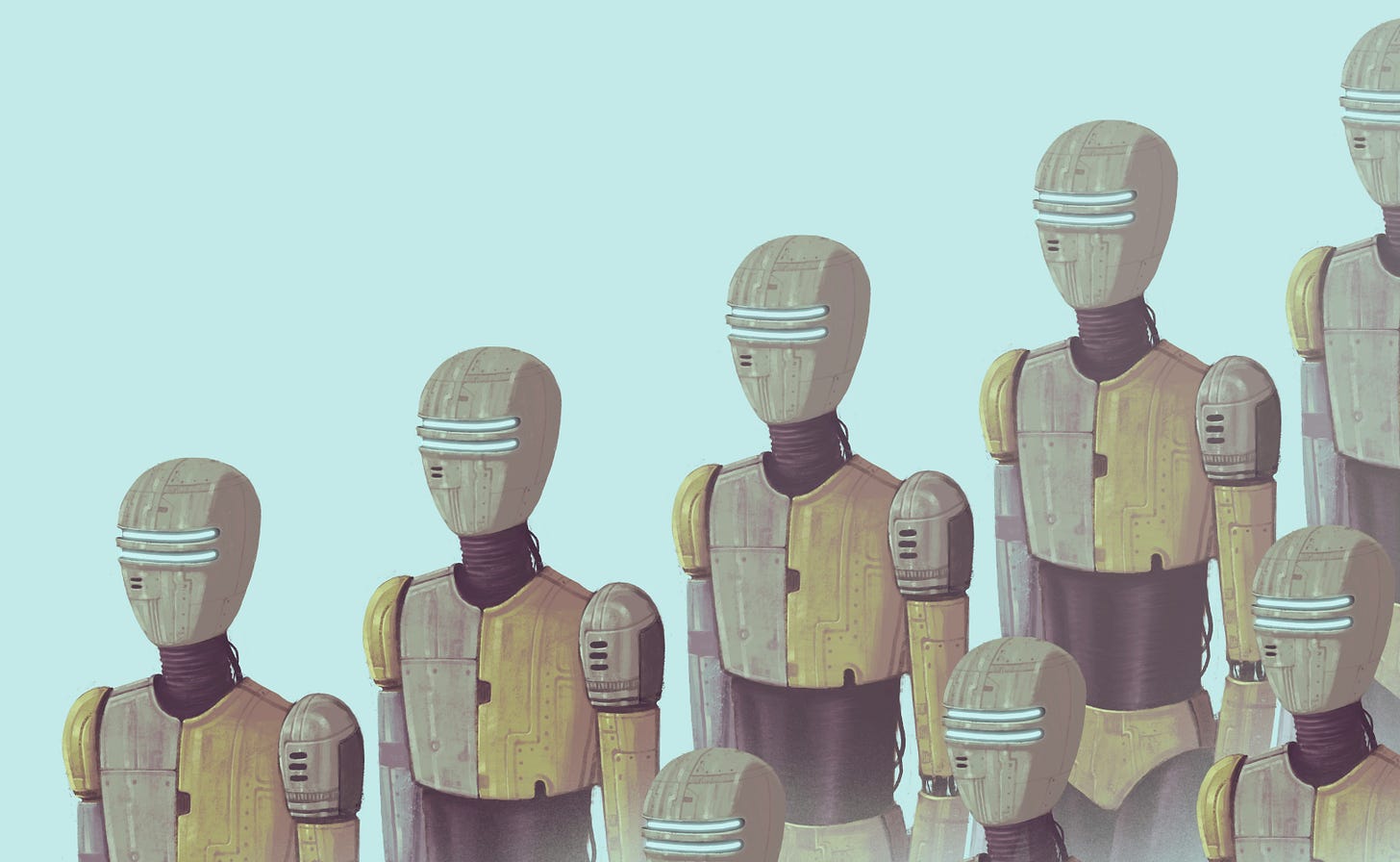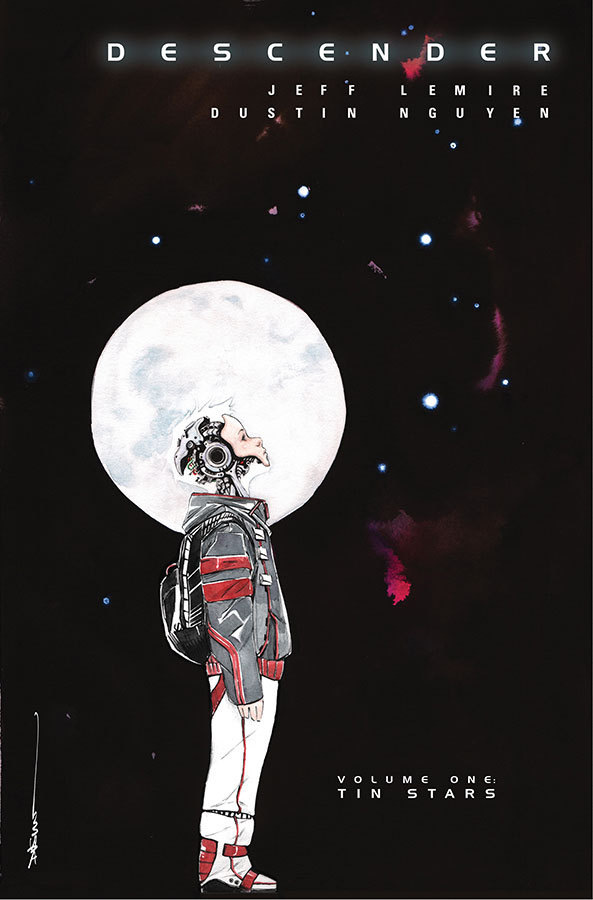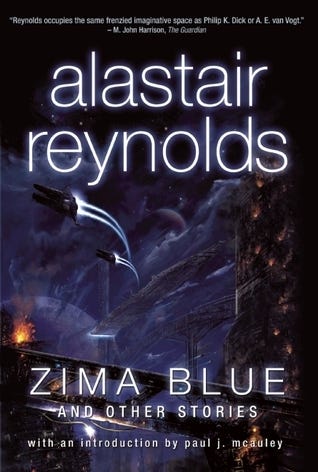When I first thought of doing this series where I delve into a certain topic and its depiction in literature, robots were the first thing that came to mind–a topic that I assume fascinates many of us. A fascination that drove me to study robotics and work in this field.
So what is it about robots that is so alluring? I asked a few of my friends this question and received varied answers. One, who also works in this field, said it’s because of the multidisciplinary approach (science, math, hardware and software engineering) with which comes the fun aspect of intermixing technologies from various sub-fields and coming up with cool projects and ideas. Another friend, whose view is through a creative writing lens, said robots are ‘humanity's attempt to almost create a new life-form in a way. Like we're "God", for lack of a better term, trying to create new creatures.’ And here I am at the juxtaposition of these perspectives, which isn’t devoid of its own woes, but more on this later.
Perhaps this fascination is also what resulted in robots being the subject of creative endeavours for ages. Sure, they might have been called different names–automatons, bots, and my favourite, robits (yes, Twilight Zone, I’m looking at you)–but contextually they are the same: a machine or device that can autonomously perform simple to complex tasks and can take any form. With that in mind, I’d like to ask, what are some of the early depictions of these machines and how has it changed over the years?
The earliest works I could think of were Asimov’s Foundation series, HAL 9000 in Clarke’s 2001: A Space Odyssey, and after much prodding of my memory banks, Tin Woodman from The Wizard of Oz (it could be argued that he isn’t a robot, but I will chalk it up to the creator’s imagination given the nascent stages of technology back then). However, I was surprised to find that the use of robots in literature dates all the way back to Homer’s Iliad from 3,000 years ago.
In Iliad, Hephaistos and Daidalos are described to craft various Automotones–metal statues that perform tasks at the behest of their creator. Machines to play music like the sirens (Keledones Khrysei- Golden Celedones), to draw chariots (Hippoi Kabeirikoi - Horses of the Cabeiri), to function as maids (Kourai Khryseai - Golden Maidens), and so on. Remember, when Illiad was written, Rome didn’t exist, most cultures were developing a writing system, and the weapons used in wars were swords and spears. There were no computers or sophisticated sensors, just ideas for how tasks could be automated with human creations. It is interesting to note though, that the two people attributed as parents to these creations were Hesphaistos, a god, and Daidalos, an architect and inventor.
If one thing these Greek gods are known for, it is their temperamental nature, their ultimate—wait for it—god complex (I’m sorry). So to speculate on why Hesphaistos created Automotones, it could be that he or other gods wanted to satisfy their privileged needs. Whereas in the case of Hesphaistos, the reasons were more circumstantial, like, you know, when he was imprisoned along with his son, Icarus on an island, he went on to create wings so that Icarus could use them to fly out. But the wings were made of wax and when Icarus flew too close to the sun, they melted. From modern day perspective, this could be seen as the wings malfunctioning, and such parallels are endless, but I digress. In any case, the use of Automotones here is practical in nature. They had problems, so they made machines to solve them–granted these descriptions are rudimentary, the idea I reckon is the same.
Coming to the more recent use of robots in literature, this reasoning changes. Take the Tin Woodman for example. His journey concerns finding a heart, of wanting to be sentient, of personhood—more of a philosophical exploration of robots. Most examples we can think of from modern day fiction explore socio-cultural themes, questions surrounding life, ethical dilemmas, and issues that are not just practical problems to solve.
In non-fiction, however, this trend is reversed.
The earliest works about robots I could find are from the 17th century and are more philosophical in nature. This hasn’t diminished by any means in recent publications, but the discussions surrounding practical utilities of a robot have dominated this space for a while now. I won’t bore you with research papers and books on how robots can be used to automate various aspects of our lives, since the talk of it is everywhere, to the point people are out with pitchforks going ‘They took err jobs!’ But this grossly overestimates the current reality of robotics. Just to put this into perspective and in hopes of gaining a deeper appreciation for the works of creative thinkers, I would like to spend some time reviewing the current state of robotics.
A few years ago when I was at an international conference on robotics, one of the keynote speakers was asked to speculate on the future of robots, and his answer was two-fold. First, he made a comment on the technology we have access to and what this means, and then how this sets limitations in what can be done, leading to creation of robots with narrow abilities–a robot that is capable of performing a few tasks but not many. Think autonomous cleaning robots and lawn-mowers, agricultural robots etc.
Philosophers, on the other hand, have always been ahead of their time. They have theorized not just what a machine is but what they might be capable of one day. Aristotle and Descartes are among the early pioneers who laid the groundwork for the concept of robots. Their works have been interpreted every which way, a hundred times over by modern philosophers, but the core idea of a machine and the discussions of consciousness (which can now be correlated to sentience) are there. For example, Descartes' work on mind-body dualism speaks of machines as beings devoid of mind and consciousness, and famously calling animals as machines. Phrasing and modern sensibilities aside, the reason I wanted to include this particular piece of non-fiction is to bring to light the early interpretations of mechanical laws, of performing commanded tasks–the groundwork for rudimentary robots.
Now a very large number of the motions occurring inside us do not depend in any way on the mind. These include heartbeat, digestion, nutrition, respiration when we are asleep, and also such waking actions as walking, singing, and the like, when these occur without the mind attending to them. When people take a fall, and stick out their hands so as to protect their head, it is not reason that instructs them to do this; it is simply that the sight of the impending fall reaches the brain and sends the animal spirits into the nerves in the manner necessary to produce this movement even without any mental volition, just as it would be produced in a machine. (Fourth Replies to Objections, Med. 7:229–30)
With how rapidly the technology is advancing, though, perhaps we will see these discussions come full circle, from philosophical insights to practical applications to ethical obligations. For now, it looks like the fictional and non-fictional explorations of robots took opposing paths, where fiction went from practicality to philosophy, and vice versa in the case of non-fiction. Maybe this is a coincidence, but because we like to search for deeper meaning, maybe this has something to say about the minds of scientific and creative pioneers. I will leave it up to you to form these speculations.
Despite the deep fascination I hold for this topic, I have yet to explore robots in my own writing. Maybe that’s because my brain is tuned to think of limitations and capabilities when it comes to robots, and simply needs to be re-tuned to come up with hypotheticals. To this day, my mind wanders to a questioning territory and refuses to accept certain aspects of a story involving robots. And at times, I simply fail to suspend logic for the sake of a good story. Although, I am happy to report that I’m getting better at turning off that critical part of my brain when consuming literature–not always, but enough to not let it deter my enjoyment.
Without further ado, here is a list of books on robots that I read and re-read recently. They range from a realistic to more imaginative, idealized depiction of machines and explore ethical and moral issues concerning personhood, individuality, accountability etc.
A quick note before we dive in: I have not included classics from the 20th century as these titles can be found with a quick search (for example, see this article over at Literary Hub). The list below contains contemporary titles, the oldest being a short story from 2005.
A Psalm for the Wild-Built
Becky Chambers
Centuries before, robots of Panga gained self-awareness, laid down their tools, wandered, en masse into the wilderness, never to be seen again. They faded into myth and urban legend.
Now the life of the tea monk who tells this story is upended by the arrival of a robot, there to honor the old promise of checking in. The robot cannot go back until the question of "what do people need?" is answered. But the answer to that question depends on who you ask, and how. They will need to ask it a lot. Chambers' series asks: in a world where people have what they want, does having more matter?
Annie Bot
Sierra Green
Annie Bot was created to be the perfect girlfriend for her human owner, Doug. Designed to satisfy his emotional and physical needs, she has dinner ready for him every night, wears the cute outfits he orders for her, and adjusts her libido to suit his moods. True, she’s not the greatest at keeping Doug’s place spotless, but she’s trying to please him. She’s trying hard.
She’s learning, too.
Doug says he loves that Annie’s artificial intelligence makes her seem more like a real woman, but the more human Annie becomes, the less perfectly she behaves. As Annie's relationship with Doug grows more intricate and difficult, she starts to wonder whether Doug truly desires what he says he does. In such an impossible paradox, what does Annie owe herself?
Klara and the Sun
Kazuo Ishiguro
From her place in the store, Klara, an Artificial Friend with outstanding observational qualities, watches carefully the behavior of those who come in to browse, and of those who pass on the street outside. She remains hopeful that a customer will soon choose her, but when the possibility emerges that her circumstances may change forever, Klara is warned not to invest too much in the promises of humans.
In Klara and the Sun, Kazuo Ishiguro looks at our rapidly changing modern world through the eyes of an unforgettable narrator to explore a fundamental question: what does it mean to love?
Descender (graphic novel)
Jeff Lemire, Dustin Nguyen
Young Robot boy TIM-21 and his companions struggle to stay alive in a universe where all androids have been outlawed and bounty hunters lurk on every planet. Written by award-winning creator, Jeff Lemire, Descender is a rip-roaring and heart-felt cosmic odyssey. Lemire pits humanity against machine, and world against world, to create a sprawling epic.
Alex + Ada (graphic novel)
Johnathan Luna, Sarah Vaughn
From JONATHAN LUNA (GIRLS, THE SWORD, ULTRA, Spider-Woman: Origin) and SARAH VAUGHN (Sparkshooter) comes ALEX + ADA, a sci-fi drama set in the near future. The last thing in the world Alex wanted was an X5, the latest in realistic androids. But after Ada is dropped into his life, he discovers she is more than just a robot.
Zima Blue
Alastair Reynolds
The renowned artist Zima recounts his mysterious past and rise to fame before unveiling his final work.
An Unnatural Life
Erin K Wagner
The cybernetic organism known as 812-3 is in prison, convicted of murdering a human worker but he claims that he did not do it. With the evidence stacked against him, his lawyer, Aiya Ritsehrer, must determine grounds for an appeal and uncover the true facts of the case.
But with artificial life-forms having only recently been awarded legal rights on Earth, the military complex on Europa is resistant to the implementation of these same rights on the Jovian moon.
Aiya must battle against her own prejudices and that of her new paymasters, to secure a fair trial for her charge, while navigating her own interpersonal drama, before it's too late."
The Murderbot Diaries
Martha Wells
"As a heartless killing machine, I was a complete failure."
In a corporate-dominated space-faring future, planetary missions must be approved and supplied by the Company. For their own safety, exploratory teams are accompanied by Company-supplied security androids. But in a society where contracts are awarded to the lowest bidder, safety isn’t a primary concern.
On a distant planet, a team of scientists is conducting surface tests, shadowed by their Company-supplied ‘droid--a self-aware SecUnit that has hacked its own governor module and refers to itself (though never out loud) as “Murderbot.” Scornful of humans, Murderbot wants is to be left alone long enough to figure out who it is, but when a neighboring mission goes dark, it's up to the scientists and Murderbot to get to the truth.











What distinguishes a machine from a robot?
Or a computer?
Perhaps we need a robot-like spectrum.
Contributing attributes might include complexity, autonomy, sentience, response to sensory input, intent, ...
The list of books seems to weigh heavily on the human form so phenotype must have some influence.
Does it need to be mechanical or could an organic structure be built? A virtual robot?
Nice article. Got me thinking a bit.
I love Alex + Ada!